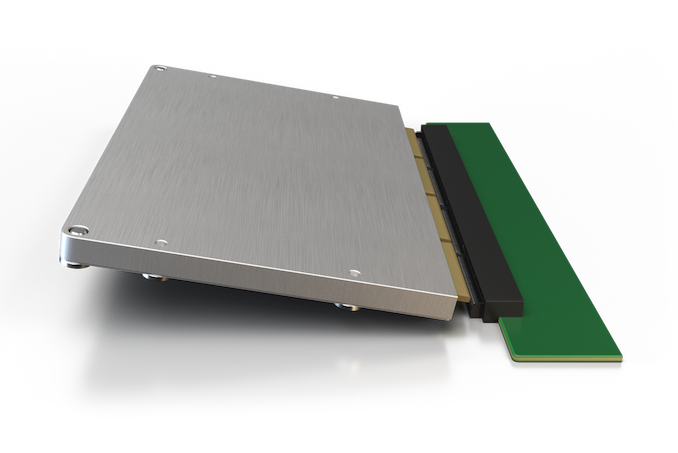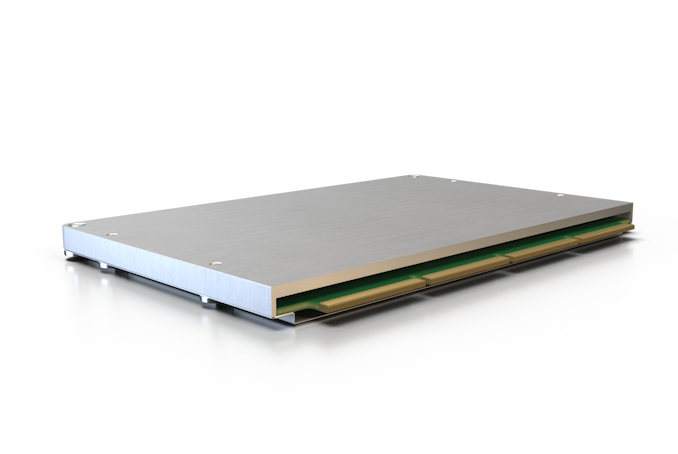Intel Launches the NUC Compute Element for Modular Computing Systems
by Ganesh T S on June 3, 2019 9:00 AM EST- Posted in
- Intel
- Systems
- Trade Shows
- NUC
- Computex 2019
- Compute Element

Intel's NUC lineup of ultra-compact and small form-factor systems has been a bright spot in the desktop PC market for the better part of this decade. Starting with the original 10cm x 10cm board, Intel has continuously been trying to push different form-factors to better target allied markets in this space. We have had slightly larger boards catering to the enthusiast market under the NUC tag (such as the Skull Canyon and Hades Canyon NUCs). More compact form-factors were experimented with in the Compute Stick family, but, that didn't last beyond a couple of years. More recently, the credit card-sized Compute Card modular computing initiative was discontinued after just one generation. However, Intel seems to have taken the feedback from the Compute Card's market deployment and developed a new product family to expand the reach of modular computing systems.
The Compute Card put the processor and RAM in a fully-enclosed credit-card sized module. It was compact and had a simple connector to enable interfacing with a dock that had the actual I/O. Though the cards and the docks eventually made its way into the retail market, the actual target audience was OEMs and other high-volume manufacturers of computing systems who could actually benefit from the modularization. For that market, the Compute Card only fulfilled a few requirements - simplification of the system-level design and the ability to create very compact systems. The cost, feature set (in terms of I/O capabilities), and performance (due to the thermal limitations inherent in a compact credit-card sized casing) were not up to the mark.
Intel's NUC Compute Element addresses these three issues (cost, performance, and increased I/O capabilities), while retaining the ability to simplify system design. Unlike the enclosed nature of the Compute Card, the NUC Compute Element is more like a Wi-Fi module with a heat spreader on top. Inclusive of the connector sticking out of the card, the NUC Compute Element comes in at 95mm x 65mm x 6mm (compared to the Compute Card's 95mm x 55mm x 5mm). It can accommodate up to U-series Core processors (typically, 15W) and provide a large performance range compared to the erstwhile Compute Card models (which topped out at 6W). The NUC Compute Element has also been optimized for battery usage for laptops, and the larger set of connector pins enable more I/O options for the final system.
One of the key driving factors in the creation of the Compute Card was the end-user accessibility for the card - enabling users to take a Card out of one device and move it to another, or take one out and replace it three years later with a newer version. However, Intel seems to have over-estimated the importance of this ability for the targeted user-base. Intel claims that the removal of the easy user accessibility in the NUC Compute Element has enabled system-design simplification and decreased the eventual system cost by around $50 - $70. Intel confirmed that a lot of the engineering effort that went into the Compute Card has come in handy for the NUC Compute Element.
We also checked with Intel about the extra I/O offered by the NUC Compute Element - while the Compute Card came with USB-C and a proprietary extension connector, the new product has a connector that simply brings out the I/O pins from the CPU. This enables device manufacturers to use the signals as they desire. The exact I/O specifications were not divulged.
It is safe to say that the NUC Compute Element, with its lower system cost compared to the Compute Card-equipped designs, will prove to be more popular among OEMs and other high-volume computing system manufacturers. In their press release, Intel indicated that education market-targeting notebooks built upon the NUC Compute Element will become available in early 2020.
| Want to keep up to date with all of our Computex 2019 Coverage? | ||||||
 Laptops |
 Hardware |
 Chips |
||||
| Follow AnandTech's breaking news here! | ||||||
Source: Intel











16 Comments
View All Comments
eastcoast_pete - Wednesday, June 5, 2019 - link
Agree. Having a U class Intel CPU in a "SMART TV" would make an AIO with a large 4K screen an interesting reality. Windows or Linux are (still) far more capable OS than the current Android or WebOS flavors.AsParallel - Monday, June 3, 2019 - link
Cool! Now I have something to put my Intel compute cards on top of :DEventually I'll have a ziggurat of products they gave up on.
mode_13h - Tuesday, June 4, 2019 - link
> Intel indicated that education market-targeting notebooks built upon the NUC Compute Element will become available in early 2020.The idea of making kids' notebooks upgradable is pretty laughable. I'd imagine kids are pretty hard on those things. I doubt most would even survive to their second upgrade. Meanwhile, in a high-volume product, the extra costs of using these modules will be non-trivial, not to speak of the extra bulk and weight.
Nice try, Intel, but ARM is sewing up the education market right in front of your eyes.
danielfranklin - Tuesday, June 18, 2019 - link
The more I think about it, the more it makes sense. Is it the CPU and ram the kids are breaking?No, it's the screens and cases. Imagine they smash their machine, pull the card out and slot it into another laptop dock the school has a pile of to share with the kids while at school (and have another dock at home).
They carry their secure data and compute in something like a CD case.
Maybe I spend too much time in the corporate world but it seems to me like it could work in education....
timecop1818 - Tuesday, June 4, 2019 - link
This is gonna be EOL the same way their Joule/Galileo/Edison stuff because nobody cares. Fucking rageberrypi compute module has more traction than any intel shit ever released.abufrejoval - Tuesday, June 4, 2019 - link
I have wanted this for many years, both in notebooks and in smartphones, where the life cycle of the compute core, the batteries and the screen/ports/case were evidently not related.In my case the exterior tends to last forever, at least since the backlights no longer used cathode ray tubes. In the case of my kids, it’s typically the opposite.
We both never get what we want from batteries: Those have a life of their own—the ability to change them should be the law everywhere on the planet.
So why am I not immediately excited that Intel finally seems to deliver?
One thing that needs serious change today is the physical abstractions of PC design: Case in point PCIe 4.0 and APUs. The hard-wired PCIe lane allocations make less sense than ever, now that APUs are seriously growing in power but also lane bandwidth has doubled on the high-end.
PCIe needs to play with signal rates and perhaps levels instead of lanes to accommodate changing notebook power scenarios, which may go as high as eGPU and as low as iGPU.
The best things that can be said about Thunderbolt is that it now shows that with USB4 every other form of USB should be pushed outside the computer core, into a docking station if really needed: I seriously hope they don’t waste contacts for USB 2/3, HDMI or the other tons of legacy interfaces PCs carry around. It should just be bundles of PCIe lanes (or better yet, InfinityFabric), and a docking station does the rest.
BTW nothing wrong with a docking station looking like a notebook, a NUC or whatever form factor you like.
That’s where I’d get really excited. And of course, AMD, ARM, RISC-V and whoever else talks PCIe/IF/CCX should be free to join an open, loyalty free and well documented standard.
Ok, I don’t think it will happen…